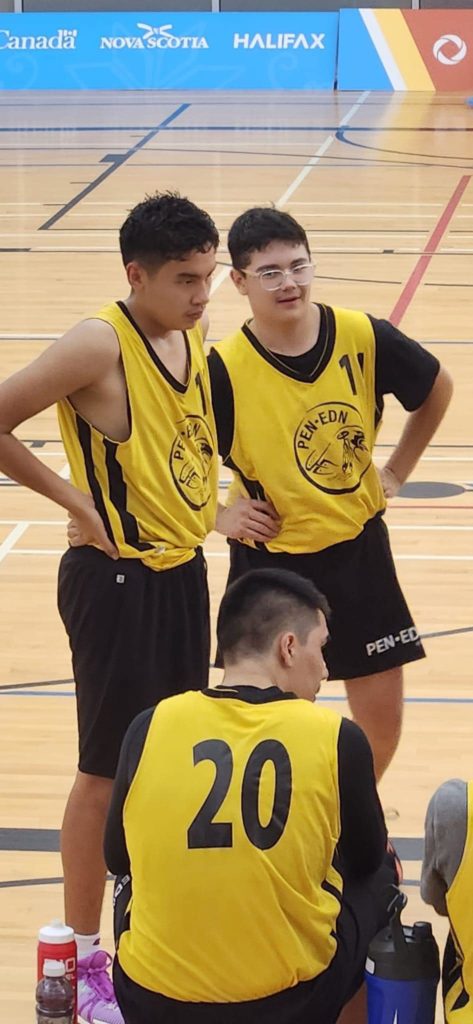The 10th North American Indigenous Games (NAIG) was held July 15-23 in Halifax and various Mi’kmaq communities in Nova Scotia. More than 5,000 teenage athletes and their coaches from 756 Nations celebrated connections through sport and culture, including several young participants from the Cree Nation.
Cree athletes joined other Indigenous youth throughout the province on Team Eastern Door and the North (EDN) at NAIG’s 16 different sports, including the more traditional Indigenous events of canoe/kayak, lacrosse and 3D archery. Darlene Shecapio Macleod was a late replacement as Team EDN’s athletics manager, accompanying the 10 participants from Mistissini.
“It was very exciting, especially seeing how proud our youth are,” said Shecapio Macleod. “This is a great opportunity – for example, my daughter (Kaylene Shecapio) went there this year for running and she was asked to come and train in Montreal for Team Canada.”
There was a relatively small contingent from Eeyou Istchee, perhaps due to a lack of promotion or the challenges of travelling to Kahnawake or Mashteuiatsh for tryouts. Forest-fire evacuations prevented some Eastmain athletes from attending. Most Cree participants were on EDN’s basketball teams, including the bronze-medal-winning male U16 team.
“I was extremely surprised Team EDN was so successful even though they only got together two weeks before for a tournament in Montreal that didn’t go well,” said Tim Matoush, father of 16-year-old Emery. “The kids started to click when they won their first game. We lost against BC in the first round so for the guys to beat them in the bronze-medal game was the icing on the cake.”
Emery Matoush emerged as one of the team’s biggest contributors at the Games, leveraging his experience playing Division 2 in Ottawa. Mistissini’s Rupert Weistche and Nolan Gunner were also on the team, the highest ranking of Canada’s entries. Emery spent most of his free time practicing on the courts and was amazed by the Indigenous talent at NAIG.

“We’d never seen Indigenous kids in competition when Emery played for Ottawa,” said Tim. “For him to see kids from all over North America was mind-blowing. He asked me: ‘Are these Indigenous kids?’”
Misha Moses, Cailyn Moses and Anna Faith Iserhoff represented Waskaganish on the U16 female basketball team. “I want youth from my community to try out more often,” said 16-year-old Misha Moses. “Have confidence in yourself. Don’t hesitate about anything and just go for it.”
Hunter Mianscum from Ouje-Bougoumou started playing golf about four years ago, when his father would take him after work every other day to a course in Chibougamau. Coaches observed that his swing showed promise, which he demonstrated with a top-five performance at his opening day at NAIG before eventually finishing at 16th.
Mianscum learned much from his gold-medal-winning roommate Tehorahkwaneken Gary Albany from Kahnawake and made many new friends from across Turtle Island. He was surprised by how huge the Games were, parading with his team at the opening ceremonies like an Olympian before a speech from Prime Minister Justin Trudeau.
“It was a nice experience staying downtown Halifax for a week,” Mianscum told the Nation. “Every time we were done our 18 holes, we would head back to our hotel and then drive around on scooters for several hours and explore places none of us had seen before.”
With most participants never previously witnessing an Indigenous gathering of such magnitude, cultural exchange was equally important as the competition. The young athletes reported an incredible sense of community, often making friends by trading pins at the cultural village.
With the Games held for the first time in Atlantic Canada, the Mi’kmaq language and culture was prominent in signs, ceremonies and demonstrations at the NAIG cultural village. The cultural village hosted demonstrations of traditional cooking from chef Ray Bear and traditional medicine from Tuma Young along with the ancient Mi’kmaq game of Waltes, beadwork, quillwork, drum making, basket weaving, storytelling and hide tanning.
The marketplace at the Halifax Common featured vendors from across the continent while musical performances occurred nightly on the main stage. Unfortunately, catastrophic flooding forced the cancellation of Friday evening’s closing ceremony and concert, which was to include Snotty Nose Rez Kids and Neon Dreams.
While the first-ever NAIG were held in Edmonton in 1990, the idea for its creation dates back to the 1970s. Founders Willie Littlechild, Charles Wood and John Fletcher recognized the importance of sports to escape the hardships of residential schools.
At an international Indigenous conference presenting the idea in 1977, Littlechild was gifted by a Brazilian Elder with a war arrow representing peace. Pointed downwards to direct anything evil toward the underground, it is now part of the event’s sacred ceremonial run.

NAIG 2023 President George (Tex) Marshall of Eskasoni Mi’kmaw Nation explained that the Games provided a safe and welcoming space for teens. “Through the dark days, sport did save my life,” he said. “That’s my whole purpose in life, to give back to sport because it saved mine and I believe it can save the lives of our youth.”
Cree athletes suggested expanding the age limit to youth up to 21. Shecapio Macleod encouraged her team to persevere with their athletic dreams, which could take them to the Masters Indigenous Games for adults 20 and over.
At Mistissini’s recent track meet, she told youth to start training now for the 2027 NAIG in Calgary. She believes the Cree Nation could field a full team, participating in a much wider variety of sporting events than are currently found in communities.
“Even though it was some of their last year, it doesn’t stop there,” asserted Shecapio Macleod. “We need the Cree Nation to introduce other sports besides broomball and hockey. We have a lot of youth who are very athletic, who have that passion for running or wrestling. We need to show our youth all these sports and support them – there’s so much out there.”





